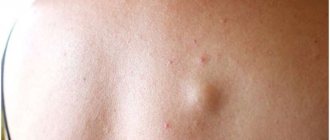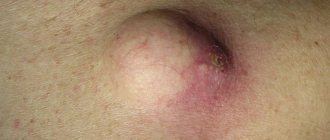Surgeon
Bohyan
Tigran Surenovich
Experience 37 years
Surgeon of the highest category, Doctor of Medical Sciences, member of the International Association of Surgeons, Gastroenterologists and Oncologists
Make an appointment
Lipoma (fat) is a benign formation in the form of small nodules, the appearance of which is associated with the accumulation and compaction of excess adipose tissue. The size of the lipoma may increase or remain stable. When exposed to unfavorable factors, pockets of pathogenic microflora can form inside the wen, which makes it a source of other serious diseases of internal organs. The unaesthetic appearance of formations protruding on the surface of the skin is also important. Therefore, in most cases, a decision is made to remove the tumor and its subsequent histological examination to clarify the nature of the wen - benign or malignant.
The area of localization of lipoma is the back, chest, face, limbs, mammary glands, structure of internal organs. The formation can be detected accidentally during diagnostic procedures or during palpation. The edges of the lipoma are dense and clear, the formation is mobile, and its palpation is painless. It is more difficult to detect a lipoma in the tissues of internal organs. However, it is precisely such cases that are recognized as the most dangerous, threatening disruptions in the functioning of the affected tissue area.
Why do lipomas occur?
To date, scientists have not been able to come to a consensus on why lipomas develop and why multiple lipomas are more common rather than single formations. Lipomatosis has nothing to do with the patient’s weight category or the amount of subcutaneous fat in his body, since formations can appear even in very slender people.
According to researchers, the appearance of wen is associated with a genetic predisposition. It can also be triggered by metabolic disorders in the body, hormonal imbalance, or thyroid disease. Some scientists are convinced that wen occurs due to malfunctions of the gallbladder and liver, as well as due to slagging in the body.
How dangerous are wen?
Lipomas never develop into malignant tumors, but since they can be located in internal organs and on the neck, compartment syndrome occurs when the tumor is large. Fatty tissues can compress blood vessels, respiratory tracts, and put pressure on bones, deforming them. Lipomas on the eyelids can interfere with normal vision and block the tear duct. Wen on the leg have a poor blood supply and can become necrotic, causing pain and intoxication.
Wen are not dangerous, but they cause trouble with their appearance. Multiple lipomas (hereditary lipomatosis) turn the skin into an unsightly bumpy surface, which repels others and creates many complexes. Modern medicine and cosmetology make it possible to get rid of wen of any location quite quickly and without problems.
When should lipomas be removed?
Most often, patients are interested in the question of whether lipomas should be removed immediately and whether it is possible to do without surgery.
It should be remembered that a lipoma is a benign formation that does not grow into the surrounding tissue. However, the problem is different: these formations tend to increase in size over time. At the same time, the lipoma “pushes apart” the tissues and organs located nearby in order to “win” a place for itself. Due to the pressure in them, metabolism can be disrupted, which is fraught with unpleasant consequences and pain.
In some cases, lipoma removal cannot be delayed. You should immediately consult a doctor if the wen has changed in appearance or you begin to feel physical discomfort. Redness of the skin over the lipoma, itching or peeling should also alert you.
Doctors recommend removing lipomas if they grow near a cluster of blood vessels or nerve cells. It is also better to “play it safe” and cut out a formation that is located in the so-called “high trauma zone” - in other words, in an area that is often exposed to external influences.
What is meant by prevention
The formation of wen on the face can be prevented by a number of preventive measures, in particular, proper nutrition.
Abuse of fast food, sweet soda, fatty foods and similar harmful things will obviously not benefit your health and will not add external beauty.
This is what often causes metabolic disorders in the body, which leads to the appearance of defects on the skin.
It is recommended to carefully review your daily diet and include more healthy foods in it:
- freshly squeezed juices (apple and grapefruit are preferred);
- fruits and vegetables;
- greenery.
It is equally important to take care of your face correctly and regularly. For oily skin, it is recommended to use scrubs and special foams for washing more often.
For dry epidermis, appropriate cleansers are selected and nourishing masks are made.
Diagnosis of lipoma and its types
Before making a decision to remove a lipoma, a diagnosis of the neoplasm is carried out, which makes it possible to determine the optimal tactics of surgical intervention.
The doctor usually begins diagnosing a lipoma with a visual examination and palpation of the formation, which makes it possible to determine the shape, structure and approximate size of the formation. An ultrasound examination is also carried out, thanks to which it becomes clear what effect the lipoma has on surrounding tissues. If the formation is located in a potentially dangerous area, the doctor may prescribe a CT or MRI. A biopsy of the formation is also often performed to find out what tissue is part of it.
Lipomas are classified depending on where they are located and what tissues they contain. A serious problem is ring-shaped lipoma, which is a large subcutaneous tumor. It wraps around the neck like a collar, causing problems with breathing and swallowing. There are fibrous lipomas, which include connective tissue; angiolipomas containing adipose tissue and blood vessels; myolipomas, which contain muscle fibers; myelolipomas, consisting of adipose tissue and elements of red bone marrow; adenolipomas, including components of the sweat gland structure; very painful perineural lipomas. For each type of tumor, there are optimal removal tactics. Tumors can be removed by conventional surgery, using the endoscopic method, laser removal, or using the so-called “radio knife”. The final decision regarding how to remove the lipoma is made by the doctor, based on the general clinical picture of the disease, as well as the patient’s condition.
Reviews
The topic can be summarized with reviews from people who have encountered the problem discussed and successfully dealt with it.
SVETLANA, 33 YEARS OLD:
“When I noticed a small scattering of small white growths near my eyes, I was very upset.
Knowing that it was dangerous to touch them yourself, I decided to undergo laser intervention. After consultation with a specialist and passing the relevant tests, the procedure was carried out.
Everything went quickly and successfully - the method is truly effective and safe.”
OLGA, 34 YEARS OLD:
“Once I discovered a small pimple on my forehead that did not heal for a long time.
I was afraid to do anything with it on my own and turned to a surgeon for advice. It turned out that it was a wen. Recommendations for laser therapy were given.
The operation took place under local anesthesia and lasted literally a quarter of an hour. As a result, not even a trace was left on the skin.”
Surgical removal of lipoma
Surgical removal of lipoma is one of the most popular methods of getting rid of lipomas. If the formation is small in diameter, surgical excision is performed under local anesthesia; if the lipoma is large, then general anesthesia is recommended.
No preliminary preparation is required before surgical removal of a lipoma. The patient, as a rule, also does not need a preoperative course of medications. Surgery is performed after an ultrasound has been performed.
After administering anesthesia, the doctor makes a small incision into the lipoma - the so-called excision. After this, he cuts out the fatty tissue and the capsule that contains it. It is the removal of the capsule that ensures that the disease does not recur. After this, the tissues are sutured in layers. In this case, self-absorbable threads can be used. An antiseptic bandage is applied to the scar. If the formation was of significant diameter, thin drainages can be used.
Depending on the complexity of the operation, the location of the lipoma and its size, the length of hospital stay ranges from one to three days. In order to relieve discomfort, painkillers are used.
Sutures are removed approximately seven to ten days after surgery. After surgical excision of the lipoma, a scar remains. Special creams and ointments will help make it less noticeable, the use of which must be agreed with your doctor.
TOP 10 folk methods
If lipomas are small in size, there is a chance to cope with them without radical methods - with folk remedies at home.
But it would be a good idea to first consult a dermatologist so as not to cause harm to your health.
Common means are presented below:
- Golden mustache. Apply the freshly picked leaf for at least 10 hours. If necessary, the procedure is repeated in subsequent days.
- Garlic. Grind garlic (1 clove), mix with vegetable oil (30 ml). Rub daily until the wen disappears.
- Egg films. Remove the films from the inside of the chicken egg shell and apply them to the white tubercles. As soon as redness and swelling appears, remove. This is done again only after the inflammation has passed.
- Celandine. You can buy ready-made celandine juice at the pharmacy or squeeze it out of the plant. Lubricate the wen and wash it off after 25-30 minutes. After a few days of such manipulations, a hole appears in the wen. Then Vishnevsky ointment is applied - the bandage is not removed for about an hour.
- Onion. First, bake the onion head in the oven until soft. Grind it into a paste and combine it with shavings of laundry soap (1 tsp). This ointment is used to lubricate problem areas twice a day.
- Honey and sour cream mixture. Combine honey, table salt and sour cream - all in equal parts. Apply the composition to the steamed skin and wait 15-20 minutes. Afterwards, wash it off.
- Aloe or Kalanchoe. Juice is squeezed out of plant leaves and used in the form of compresses.
- Nettle. An alcohol tincture is made from 500 ml of vodka and 60 g of nettle raw materials. Infuse for 20-22 days in a dark and cool place. Apply as needed - externally.
- Lamb fat. The product is first heated in a steam bath, cooled and the wen is lubricated. The same is done every day for a month.
- Chestnuts. Twist chestnuts (4-5 pieces) through a meat grinder and add 15 g of natural honey. Apply the mixture 3-4 times a day.
Contraindications for surgery
Surgical removal of a lipoma, like any other surgical intervention, has a wide range of contraindications.
- Thus, surgical removal of wen is not performed on women in an “interesting” position, or during breastfeeding. Doctors recommend refusing surgery during “critical days.”
- Herpes, recent colds or infectious diseases are also reasons to undergo surgery.
- It is highly undesirable to perform surgical removal of a wen if the patient has been diagnosed with diabetes.
- Surgical removal is also fraught with complications due to secondary immunodeficiency - in other words, reduced body resistance.
Benefits of using a laser
It is worth immediately highlighting the advantages of laser therapy:
- painlessness;
- minimal risk of possible relapse;
- absence of scars, cicatrices and swelling after surgery;
- short duration of the session – maximum 30 minutes;
- no side effects;
- The patient is monitored on an outpatient basis;
- short rehabilitation period.
As a result of such an effect, the wen disappears without a trace.
Other lipoma removal methods
In addition to surgical excision of the lipoma, there are other methods for removing the tumor. Each of them has its own advantages and disadvantages.
Laser removal
Laser surgery is one of the most innovative methods for removing fatty tissue. Most often, this option is used to remove formations on the face and neck, since the procedure leaves virtually no scars. Moreover, since the fatty tissue is removed along with the capsule, the likelihood of relapse is reduced to almost zero.
During this operation, the laser simultaneously performs two functions: a scalpel and a coagulator, cutting tissue and at the same time preventing the development of bleeding. Therefore, laser removal is bloodless, due to which healing occurs quickly and swelling and suppuration do not develop. Since laser removal is a non-contact method, it is completely sterile. The duration of the laser removal operation is about thirty minutes, manipulations are carried out using local anesthesia.
Contraindications to laser removal of a wen are a history of cancer, diabetes, pregnancy and inflammatory processes.
Radio wave method
The radio wave method or the so-called “radio knife” is excellent for getting rid of lipomas of small diameter. Its essence is the impact on formation of intense electromagnetic radiation. High-frequency waves perform the duties of a scalpel, cutting tissue. Under the influence of the “radio knife”, heat begins to be generated in the cells, as a result of which they self-destruct. In this case, under the influence of radio waves, the wound is disinfected and coagulated.
The undeniable advantage of removing lipomas using a “radio knife” is that such an intervention is bloodless. In addition, thanks to the use of local anesthesia, the manipulation is painless. Radio wave removal of a tumor eliminates the possibility of complications: in particular, wound infection, swelling, and suppuration.
Postoperative rehabilitation requires minimal time - within a week or two the wound heals completely, leaving no scars. There is also no need for a hospital stay.
Puncture-aspiration method
The puncture-aspiration method of lipoma removal is also effective. During this procedure, a needle is inserted into the tumor, after which the entire contents of the tumor are drawn out with a special syringe-pump. However, this method has one significant drawback - since the capsule remains in the same place, a relapse may develop. Also, an even larger wen may appear if, after “sucking out” the tumor, at least a tiny fragment of the formation remains under the skin.
And since such liposuction is performed blindly, without visual control, it is impossible to guarantee complete removal of the tumor.
Endoscopic surgery
One of the innovative methods, characterized by low trauma and excellent cosmetic effect, is endoscopic removal of lipoma. In this case, the incision is made not on the tumor itself, but at some distance from it: as a rule, in the folds of the skin, in areas hidden from prying eyes. After this, an endoscope and instruments are inserted into the incision, with the help of which the wen is removed.
Cost of laser therapy
The cost of removing a wen on the face varies, which is influenced by its size and location. This is why the cost varies.
A number of other factors also influence how much it costs to remove a wen on the face: region, status of the clinic, professionalism of the surgeon, complexity of the operation.
Doctors distinguish 3 categories according to the degree of complexity, according to which the average price is set. So, laser removal of wen on the face in Moscow and the Moscow region is as follows:
- Small lipomas located in simple, anatomically speaking, places - from 1,500 to 6,000 rubles.
- Complex neoplasms of medium size - 2500-10000 rubles.
- Large tumors – from 7,000 rubles.
For comparison, you can imagine the prices for removing wen in St. Petersburg and other, more remote regions. So in St. Petersburg they charge an average of 250-300 rubles for the procedure. for a unit.
Removing a wen on the face in Samara will cost about the same price. But the price tag in Krasnodar is practically the same as in Moscow.
Expert opinion
- Cosmetologist
- Surgeon
Michelle Ellern
practicing cosmetologist-dermatologist
When deciding to remove lipomas with a laser, it is advisable to choose a medical institution where such operations are performed by professional surgeons. To do this, a statistical analysis is carried out on available reviews on the Internet and other resources. It is better if these are recommendations from friends who have already used the services of a particular clinic. Cost plays a role, but not the key one – health is more important.
Theda Contis
plastic surgeon
White fatty formations on the epidermis of the face (with the exception of the eye area) can be carefully removed by yourself by piercing with a needle and squeezing out. Only for this purpose certain safety measures are followed - the instrument, the place of planned manipulations and hands are thoroughly disinfected with alcohol. After removing the contents, be sure to treat the wound with an antiseptic.
Wen causes aesthetic discomfort, especially on the face. As a result, a person may begin to develop complexes. You shouldn’t put up with this, because there is more than one option for removing a wen.
What examinations are prescribed in preparation for radio wave removal of fatty tissues?
The list of necessary tests is prescribed by a dermatologist after a preliminary conversation and examination of the patient to study the medical history and identify the number of lipomas, their location and size.
The standard list of tests before the upcoming procedure includes:
- general blood and urine tests;
- coagulogram;
- blood biochemistry;
- blood for sugar;
- examination for hidden infections.
According to indications, CT or ultrasound of soft tissues is prescribed, which makes it possible to determine the depth of the lipoma.










